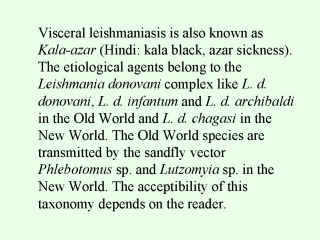| front |1 |2 |3 |4 |5 |6 |7 |8 |9 |10 |11 |12 |13 |14 |15 |16 |17 |18 |19 |20 |21 |22 |23 |24 |25 |26 |27 |review |
 |
There is no guaranteee that any identifications from
Giemsa slides by microscope are true by species, although they are likely correct by the
traditional history of the given localities, and according to the pathogenesis. An inflammatory reaction is found with plasma cells and macrophages with abundant parasites at the sites of the inoculation of the infecting forms. The lesion ulcerates producing abundant exudate, granulomatous tissue and necrosis. The ulcer, most often circular, has well defined reddened edges. Not painful, the lession can spontaneously cure within a year. Curiously, L. mexicana, cause of ulcera de chicleros, can leave a nodule on the ear. In disseminated leishmaniasis, the lession can be an ulcer or nodule followed by more lesions that can cover much of the skin. Most are superficial and do not produce metastasis and are chronic, possibly resistant to treatments. |